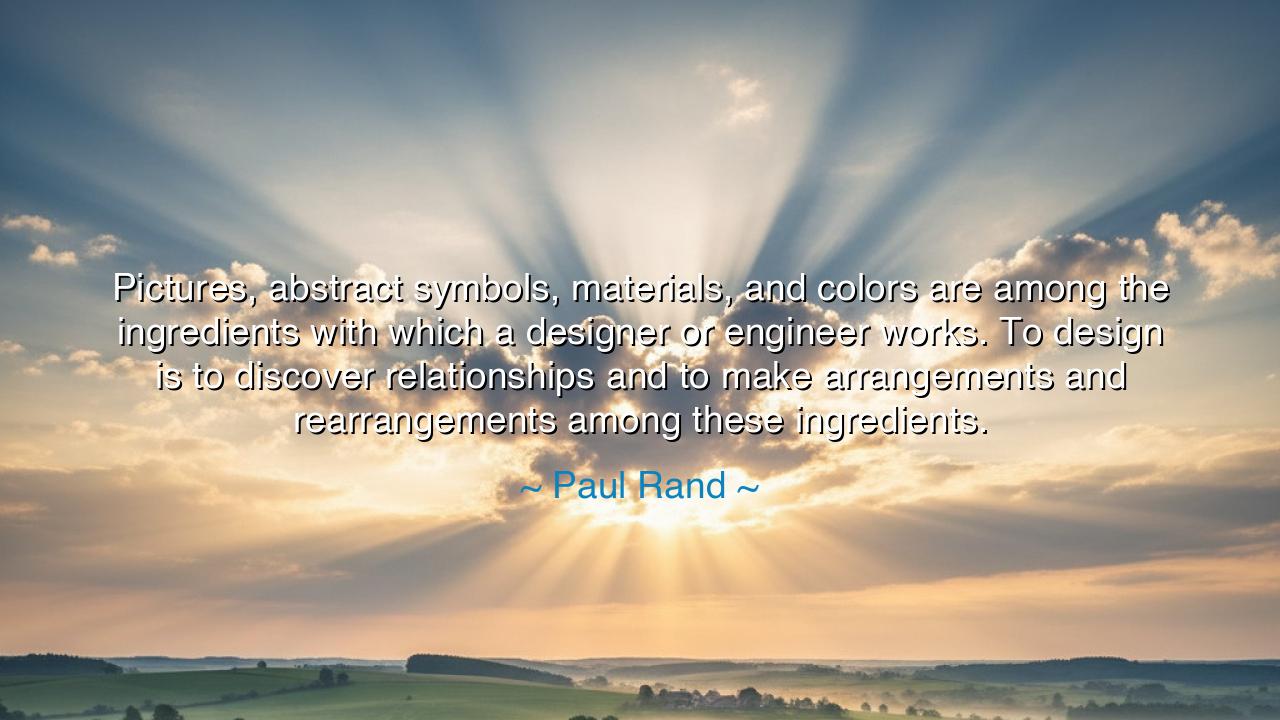
Pictures, abstract symbols, materials, and colors are among the
Pictures, abstract symbols, materials, and colors are among the ingredients with which a designer or engineer works. To design is to discover relationships and to make arrangements and rearrangements among these ingredients.






When Paul Rand, the great master of visual design, proclaimed, “Pictures, abstract symbols, materials, and colors are among the ingredients with which a designer or engineer works. To design is to discover relationships and to make arrangements and rearrangements among these ingredients,” he was not merely describing a craft — he was unveiling a philosophy of creation. His words echo the wisdom of the ancients, for they speak of harmony, order, and the hidden patterns that bind all things together. In his view, design is not simply the act of making something beautiful or functional — it is the art of discovering relationships, of bringing unity out of chaos, and of shaping meaning from the raw matter of the world.
Rand, who shaped the visual identity of great American companies like IBM, ABC, and UPS, believed that the essence of design lay in the interplay between elements — between form and function, color and composition, symbol and substance. His words reveal that a designer is not unlike a philosopher or a composer: they seek not to create from nothing, but to reveal order within what already exists. Just as the ancient sculptor saw the figure hidden within the marble, the designer perceives hidden connections between line, shape, texture, and tone — and through patience and insight, brings them into balance. This process, he reminds us, is one of discovery, not domination; the designer listens to the materials, lets them speak, and arranges them into harmony.
The meaning of Rand’s quote runs deeper than the surface of art or design. To “discover relationships” is to see the world as an interconnected web — to understand that nothing stands alone, and that every element gains meaning only in relation to the others. A single color has no voice until it stands beside another; a symbol has no significance until placed in a context. Likewise, in life, every person, idea, and action finds its purpose through its connection to others. The designer’s task, then, is a mirror of the universal human task: to find balance and relationship in the midst of multiplicity, to weave unity from diversity.
Consider the work of Leonardo da Vinci, who embodied this very truth. To him, art and engineering were not separate callings but two sides of one divine pursuit — the understanding of relationships. In his sketches of flying machines, in his studies of anatomy, and in his paintings, Leonardo sought the same thing that Rand described: the harmonious arrangement of parts into a coherent whole. The curve of a wing mirrored the curve of a leaf; the golden ratio linked the proportions of the human body to the architecture of temples. Through observation and arrangement, Leonardo saw that design was a reflection of cosmic order — the language through which the human mind converses with creation.
Rand’s insight also teaches humility. The designer does not command beauty; he discovers it. He does not impose his will upon the materials, but listens to them — to the way light bends across a surface, to the rhythm of repetition, to the silence between forms. The ancients would have called this approach techne, the sacred art of craft guided by knowledge. It is through this reverence for relationship that the designer becomes an instrument of truth. In Rand’s world, a good design is not merely clever; it is inevitable — it feels as if it could exist in no other way. Such inevitability is born from deep understanding, from a harmony between thought and material that can only be achieved by those who have seen beyond appearance to essence.
In our age, where haste and noise dominate creation, Rand’s words are a call to return to discipline and discovery. Too often, we mistake design for decoration, or creativity for chaos. But true creation, as he reminds us, is not an explosion — it is a composition. It requires the humility to explore, to experiment, to rearrange, again and again, until the parts sing together. Whether one is an artist, a builder, or simply a maker of one’s own destiny, the lesson is the same: every act of design — of life — is an act of relationship.
So, O seeker of form and meaning, take heed of Paul Rand’s wisdom: to design is to arrange, and to live is to relate. See the world as a canvas of possibilities, where every element — every color, every word, every moment — can be placed in harmony with another. Be patient in your making; experiment, refine, and listen deeply. For in discovering relationships — between art and science, between self and others, between what is and what could be — you will find not only beauty, but truth. And when your work, your creation, or your life stands balanced and whole, you will know that you, too, have become a designer in the grand workshop of existence.






AAdministratorAdministrator
Welcome, honored guests. Please leave a comment, we will respond soon